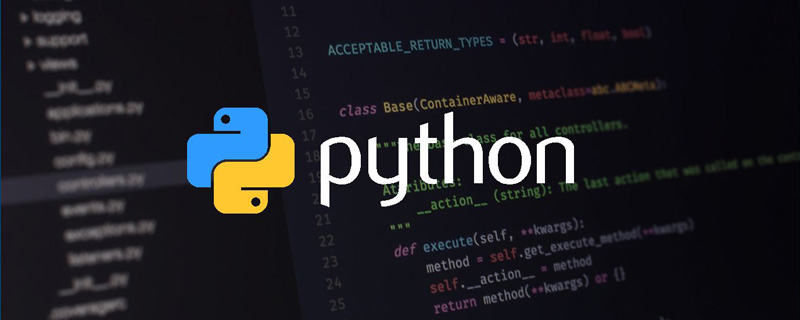 Backend Development
Backend Development
 Python Tutorial
Python Tutorial
 Practical records of some problems in saving and loading pytorch models
Practical records of some problems in saving and loading pytorch models
Practical records of some problems in saving and loading pytorch models
This article brings you relevant knowledge about Python, which mainly introduces practical records of some problems in saving and loading pytorch models. Let’s take a look at them together. I hope it will be helpful to everyone. help.
[Related recommendations: Python3 video tutorial ]
1. How to save and load models in torch
1. Saving and loading model parameters and model structure
torch.save(model,path) torch.load(path)
2. Only saving and loading model parameters - this method is safer, but a little more troublesome
torch.save(model.state_dict(),path) model_state_dic = torch.load(path) model.load_state_dic(model_state_dic)
2. Problems in model saving and loading in torch
1. Problems in loading after saving the model structure and parameters in a single card model
When the model is saved, the path to the model structure definition file will be recorded. , when loading, it will be parsed according to the path and the parameters will be loaded; when the model definition file path is modified, an error will be reported when using torch.load(path).
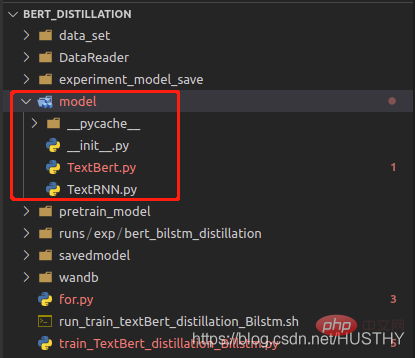
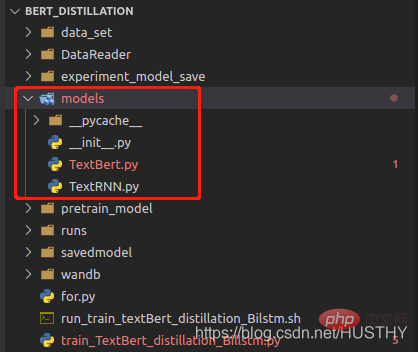

After changing the model folder to models, an error will be reported when loading again.
import torch from model.TextRNN import TextRNN load_model = torch.load('experiment_model_save/textRNN.bin') print('load_model',load_model)
In this way of saving the complete model structure and parameters, be sure not to change the model definition file path.
2. After saving the single-card training model on a multi-card machine, an error will be reported when loading it on a single-card machine.
If there are multiple graphics cards on a multi-card machine, starting from 0, the model is now n>= After the graphics card training on 1 is saved, the copy is loaded on a single-card machine
import torch from model.TextRNN import TextRNN load_model = torch.load('experiment_model_save/textRNN_cuda_1.bin') print('load_model',load_model)
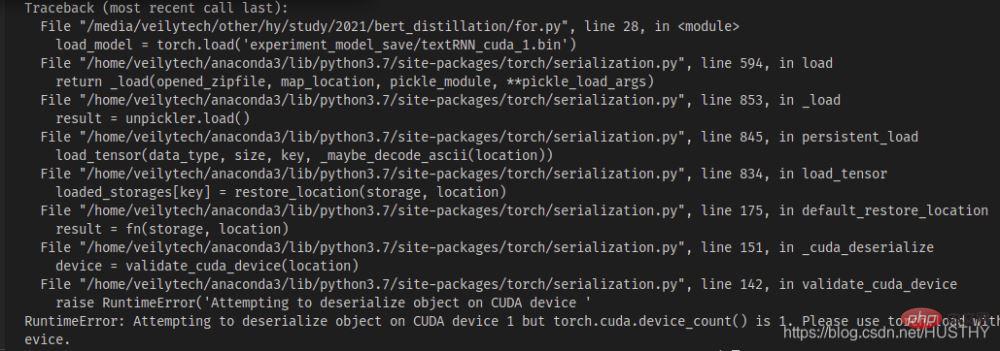
There will be a cuda device mismatch problem - the model code segment widget type you saved If you use cuda1, then when you use torch.load() to open it, it will look for cuda1 by default, and then load the model to the device. At this time, you can directly use map_location to solve the problem and load the model onto the CPU.
load_model = torch.load('experiment_model_save/textRNN_cuda_1.bin',map_location=torch.device('cpu'))
3. Problems that occur after saving the model structure and parameters of the multi-GPU training model and then loading it
When using multiple GPUs to train the model at the same time, whether the model structure and parameters are saved together or separately Model parameters will cause problems when loading under a single card
a. Save the model structure and parameters together and then use them when loading

torch.distributed.init_process_group(backend='nccl')
The above-mentioned multi-process method, so you must declare it when loading, otherwise an error will be reported.
b. Saving model parameters separately
model = Transformer(num_encoder_layers=6,num_decoder_layers=6) state_dict = torch.load('train_model/clip/experiment.pt') model.load_state_dict(state_dict)
The same problem will occur, but the problem here is that the key of the parameter dictionary is different from the key defined by the model

The reason is that under multi-GPU training, when using distributed training, the model will be packaged. The code is as follows:
model = torch.load('train_model/clip/Vtransformers_bert_6_layers_encoder_clip.bin') print(model) model.cuda(args.local_rank) 。。。。。。 model = nn.parallel.DistributedDataParallel(model,device_ids=[args.local_rank],find_unused_parameters=True) print('model',model)
Model structure before packaging:

Packaged model
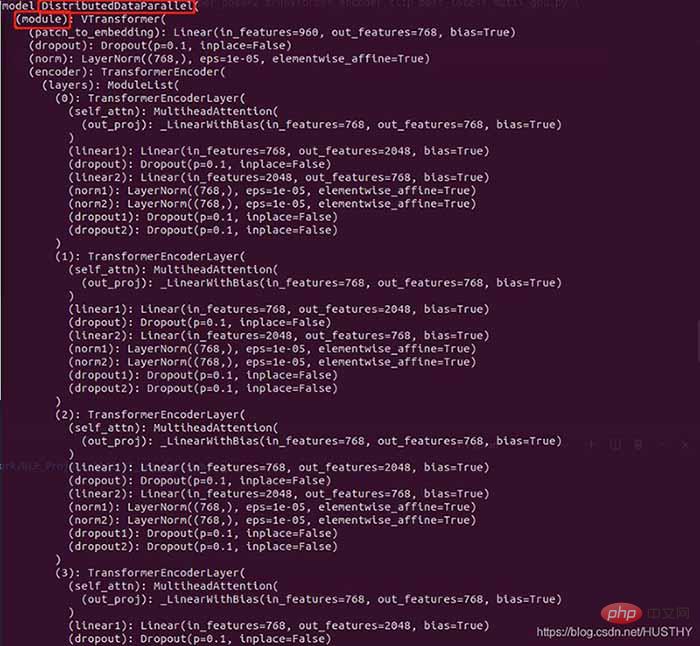
There are more DistributedDataParallel and modules in the outer layer, so the weight will appear when loading the model weight in a single card environment The keys are inconsistent.
3. The correct method of saving and loading the model
if gpu_count > 1:
torch.save(model.module.state_dict(),save_path)
else:
torch.save(model.state_dict(),save_path)
model = Transformer(num_encoder_layers=6,num_decoder_layers=6)
state_dict = torch.load(save_path)
model.load_state_dict(state_dict)This is a better paradigm, and there will be no error in loading.
【Related recommendations: Python3 video tutorial】
The above is the detailed content of Practical records of some problems in saving and loading pytorch models. For more information, please follow other related articles on the PHP Chinese website!

Hot AI Tools

Undresser.AI Undress
AI-powered app for creating realistic nude photos

AI Clothes Remover
Online AI tool for removing clothes from photos.

Undress AI Tool
Undress images for free

Clothoff.io
AI clothes remover

AI Hentai Generator
Generate AI Hentai for free.

Hot Article

Hot Tools

Notepad++7.3.1
Easy-to-use and free code editor

SublimeText3 Chinese version
Chinese version, very easy to use

Zend Studio 13.0.1
Powerful PHP integrated development environment

Dreamweaver CS6
Visual web development tools

SublimeText3 Mac version
God-level code editing software (SublimeText3)

Hot Topics
 1378
1378
 52
52
 How to use Debian Apache logs to improve website performance
Apr 12, 2025 pm 11:36 PM
How to use Debian Apache logs to improve website performance
Apr 12, 2025 pm 11:36 PM
This article will explain how to improve website performance by analyzing Apache logs under the Debian system. 1. Log Analysis Basics Apache log records the detailed information of all HTTP requests, including IP address, timestamp, request URL, HTTP method and response code. In Debian systems, these logs are usually located in the /var/log/apache2/access.log and /var/log/apache2/error.log directories. Understanding the log structure is the first step in effective analysis. 2. Log analysis tool You can use a variety of tools to analyze Apache logs: Command line tools: grep, awk, sed and other command line tools.
 Python: Games, GUIs, and More
Apr 13, 2025 am 12:14 AM
Python: Games, GUIs, and More
Apr 13, 2025 am 12:14 AM
Python excels in gaming and GUI development. 1) Game development uses Pygame, providing drawing, audio and other functions, which are suitable for creating 2D games. 2) GUI development can choose Tkinter or PyQt. Tkinter is simple and easy to use, PyQt has rich functions and is suitable for professional development.
 PHP and Python: Comparing Two Popular Programming Languages
Apr 14, 2025 am 12:13 AM
PHP and Python: Comparing Two Popular Programming Languages
Apr 14, 2025 am 12:13 AM
PHP and Python each have their own advantages, and choose according to project requirements. 1.PHP is suitable for web development, especially for rapid development and maintenance of websites. 2. Python is suitable for data science, machine learning and artificial intelligence, with concise syntax and suitable for beginners.
 How debian readdir integrates with other tools
Apr 13, 2025 am 09:42 AM
How debian readdir integrates with other tools
Apr 13, 2025 am 09:42 AM
The readdir function in the Debian system is a system call used to read directory contents and is often used in C programming. This article will explain how to integrate readdir with other tools to enhance its functionality. Method 1: Combining C language program and pipeline First, write a C program to call the readdir function and output the result: #include#include#include#includeintmain(intargc,char*argv[]){DIR*dir;structdirent*entry;if(argc!=2){
 The role of Debian Sniffer in DDoS attack detection
Apr 12, 2025 pm 10:42 PM
The role of Debian Sniffer in DDoS attack detection
Apr 12, 2025 pm 10:42 PM
This article discusses the DDoS attack detection method. Although no direct application case of "DebianSniffer" was found, the following methods can be used for DDoS attack detection: Effective DDoS attack detection technology: Detection based on traffic analysis: identifying DDoS attacks by monitoring abnormal patterns of network traffic, such as sudden traffic growth, surge in connections on specific ports, etc. This can be achieved using a variety of tools, including but not limited to professional network monitoring systems and custom scripts. For example, Python scripts combined with pyshark and colorama libraries can monitor network traffic in real time and issue alerts. Detection based on statistical analysis: By analyzing statistical characteristics of network traffic, such as data
 Python and Time: Making the Most of Your Study Time
Apr 14, 2025 am 12:02 AM
Python and Time: Making the Most of Your Study Time
Apr 14, 2025 am 12:02 AM
To maximize the efficiency of learning Python in a limited time, you can use Python's datetime, time, and schedule modules. 1. The datetime module is used to record and plan learning time. 2. The time module helps to set study and rest time. 3. The schedule module automatically arranges weekly learning tasks.
 Nginx SSL Certificate Update Debian Tutorial
Apr 13, 2025 am 07:21 AM
Nginx SSL Certificate Update Debian Tutorial
Apr 13, 2025 am 07:21 AM
This article will guide you on how to update your NginxSSL certificate on your Debian system. Step 1: Install Certbot First, make sure your system has certbot and python3-certbot-nginx packages installed. If not installed, please execute the following command: sudoapt-getupdatesudoapt-getinstallcertbotpython3-certbot-nginx Step 2: Obtain and configure the certificate Use the certbot command to obtain the Let'sEncrypt certificate and configure Nginx: sudocertbot--nginx Follow the prompts to select
 How to configure HTTPS server in Debian OpenSSL
Apr 13, 2025 am 11:03 AM
How to configure HTTPS server in Debian OpenSSL
Apr 13, 2025 am 11:03 AM
Configuring an HTTPS server on a Debian system involves several steps, including installing the necessary software, generating an SSL certificate, and configuring a web server (such as Apache or Nginx) to use an SSL certificate. Here is a basic guide, assuming you are using an ApacheWeb server. 1. Install the necessary software First, make sure your system is up to date and install Apache and OpenSSL: sudoaptupdatesudoaptupgradesudoaptinsta



